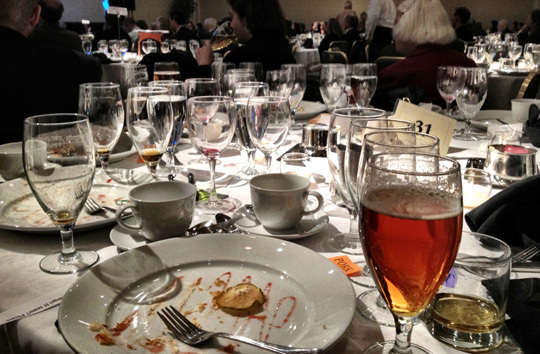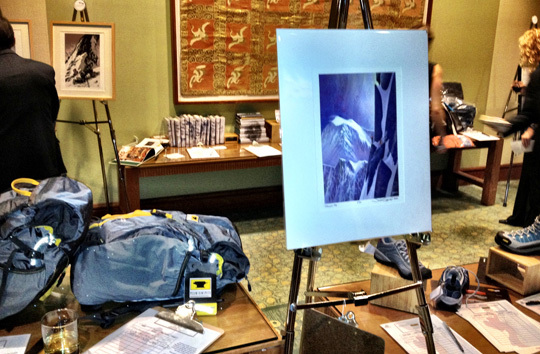
The remains of the 2012 American Alpine Club Benefit Dinner. [Photo] Keese Lane
Beards and Bow Ties
“Do I hear $3,000. $3,000. $3,500. $3,500. Yes, $3,500.”
Empty wine glasses covered the table as I watched an ice axe sell for the same amount as the combined price of my first, second and current Saab 900. My eyes met those of Alpinist‘s Assistant Editor, and we both raised our eyebrows. We were seated in the back of Boston’s Seaport Hotel conference room watching the bidding frenzy of the American Alpine Club’s Annual Benefit Dinner. White haired men raised their fingers and numbered cards to bid on art, travel and collectors’ items. We were a long way from the mountains, dressed not in Gore-Tex but in black suits and dresses. I took my scotch and slipped from the dining room. In the hallway mingled a handful of climbers and reps whose tans and partially trimmed facial hair contrasted with their pressed suits. Everyone seemed to be eyeing the others, observing their duds and comparing who pulled off the hoitey-toitey look best. Their usual canned domestic beer replaced with wine and scotch. The division at the event was clear. Inside the ballroom were the people who could call this event home, those who had $4,000 to bid on a painting of an ice climber. Laughing in the hallway were industry people, climbers, media, reps for various manufacturers–most faking the ease with which they wore their black ties. Missing from the event were my partners: the men and women who climb everyday and don’t have a media pass to get them past the $125 plate fee.
“At either end of the socioeconomic spectrum there is a leisure class.” – Eric Beck
Abruzzi was a duke. Cassin was a steel worker. Perry-Smith came from family money. Heckmair was a gardener. The climbing community has always spanned the gap between those with the independent wealth to travel and climb, and those who have forsaken everything else for the mountains. I cannot claim to be as destitute as Heckmair or as dedicated as Cassin, but I always felt some jealousy for my partners’ racks of shiny new cams and wiregates. My gear came off the consignment rack of the local gear exchange. The AAC Benefit Dinner was the territory of the higher end leisure class and a strange window into a society many of us at the other end of the spectrum barely understand or know about. Still it was exciting to jump the old boundaries and mingle before dinner with club members from across the spectrum.

Representatives of the climbing media on their way to the AAC Dinner. [Photo] Keese Lane
Go West Old Man
For almost a century the AAC was branded as an elitist organization, and it was one. Prospective members had to be nominated and their climbing resumes and cover letters approved in order to gain admittance into the exclusive club. As climbers basked in Camp Four during the Yosemite glory days, the AAC maintained their physical presence in New York City. However, since the reign of Club Presidents Jim McCarthy and Glenn Porzak, the AAC has been taking the advice of Horace Greeley and moving West, to Colorado, trying to appeal to younger and more diverse members of the community. In the late ’80s and early ’90s the Club began to slowly shift directions– away from its past as an old boy’s network of a few thousand individuals, towards a truly national climbing association. Creating and then spinning off the Access Fund as well as playing a role in the creation of sport climbing competitions in the US, the Club embraced the greater climbing community. Now the AAC is a year into its Five Year Plan. Membership in the AAC has reached record levels and, with initiatives like the Live Your Dreams Grant and the Sport Climbing Award, the Club is making an effort to appeal to a younger and less elite audience.

Items in the silent auction at the Dinner. [Photo] Keese Lane
However
Despite their efforts, I cannot help but hear an echoing “but” hanging over the new movement. As the AAC held to its elite role and reviewed applicant’s resumes the Vulgarians of the East climbed naked and carried kegs up Cannon while a certain Western secret society may or may not have dynamited a bridge to keep its clubhouse undisturbed. Now the AAC is seeking to fill the role it neglected as a club for climbers of all grades and styles. But other local and national organizations have closed the gaps left by the AAC, providing education, community and resource protection to climbers regardless of their credentials. When the self-addressed envelopes appear in my mailbox from Crag VT, SWMCC, the Access Fund, the AAC and Friends of Hyalite, I will feel the need to give back to the organizations that made me the climber I am today. But I doubt I will be sending back checks to every one of these organizations.
Standing in the hallway, I accepted the offer of bourbon from a representative of a gear manufacturer and chatted with a casually dressed Kurt Diemberger and a very fashionable local hardman. Word spread that the bidding frenzy had ceased and Mark Richey, Steve Swenson and Freddie Wilkinson took the stage to talk about Saser Khangri II. Refilling our tumblers, we headed back into the dark room.
Presidential Climbings
I listened to them share their Saser Khangri II experience and was struck by how much they’d devoted themselves to climbing and alpinism, a strange contrast to the auction. Watching video footage of Swenson hacking chunks of God-knows-what from his lungs in a cramped tent above an audience with gold watches and pearls was by far the most unique part of the night. The Dinner was one of the most unique gatherings I have ever witnessed in the climbing community, and the only one I’ve attended wearing a bow tie. Two weeks after the event, I am still impressed with the balancing act performed by a club simultaneously attracting the elite of Boston and courting the dirtbags of the climbing community.
Where ALL Climbers Unite
One year into its Five Year Plan, the AAC is attempting to place itself at the center of a more broadly defined American climbing world. Still heavily funded by the elites, the Club’s century of Eastern privilege was very clear at the Boston fundraising dinner. But Mark Richey, and Steve Swenson, both past presidents of the Club, have truly lived the climbing life. And with the formation of the regional coordinator positions, Live Your Dreams Grant and John L. Horn Memorial Sport Climbing Award, the AAC is backing its lofty plans with cash and manpower committed to aspects of the sport it has long neglected. The big question seems to be how the Club will manage and integrate with the climbing organizations that grew prior to the AAC’s interest in the average climber.
I hope that next year, as I sip a free drink and watch an autographed piece of gear sell for more than the value of my rack, I can share a raised eyebrow and comfortable evening with my partners– the ones who crush moderate routes and scare themselves on the old classics.